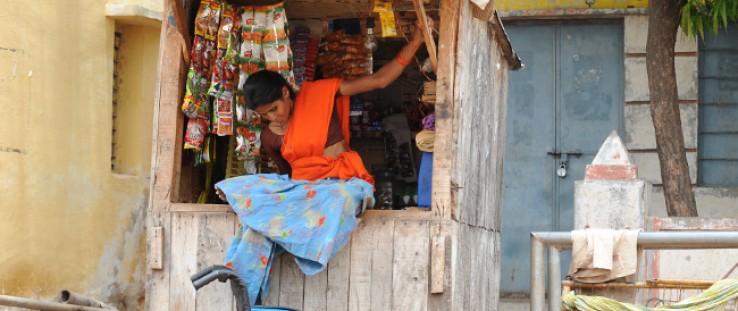 Lalithamma’s new wheelchair allows her greater independence, including moving about to buy materials for her shop.
CREDIT: CHAPAL KHASNABIS, WORLD HEALTH ORGANIZATION
Lalithamma’s new wheelchair allows her greater independence, including moving about to buy materials for her shop.
CREDIT: CHAPAL KHASNABIS, WORLD HEALTH ORGANIZATION
 Lalithamma’s new wheelchair allows her greater independence, including moving about to buy materials for her shop.
CREDIT: CHAPAL KHASNABIS, WORLD HEALTH ORGANIZATION
Lalithamma’s new wheelchair allows her greater independence, including moving about to buy materials for her shop.
CREDIT: CHAPAL KHASNABIS, WORLD HEALTH ORGANIZATION
About 1 percent of the world’s population, or just over 65 million people, need a wheelchair.
The majority of these people live in developing countries, and are part of a much broader community of people with disabilities—1 billion people or 15 percent of the world’s population—that also lack equal access to health care, education, and employment opportunities. They are essentially excluded from everyday life and from full enjoyment of their human rights.
Less than 5 percent of those in need of a wheelchair actually have access to a properly fitted chair due to the devices’ relatively high cost compared to income levels, and the limited number of service providers and properly trained human resources.
The majority of wheelchairs used around the world are donated and often mass distributed. Chairs come not only without the user’s needs being properly assessed by a trained technician or therapist, but also without the wheelchair ever being fit to the user’s body. Users, some of whom are receiving a chair for the first time in their lives, are often not trained in how to use them.
According to the Interdisciplinary Journal of Rehabilitation, “Various studies indicate that pressure sores affect millions of people each year, with many of these sores coming as a result of improperly fitted wheelchairs…the problems can lead to amputation, autonomic dysreflexia (over-activity of the autonomic nervous system), or even premature death.”
Providing well-designed wheelchairs to users that are appropriate to their needs, including their environment, enhances the users’ ability to move around, and opens up the possibilities for education, work, and an active social life.
Rob Horvath, manager of USAID’s programs for wheelchair users, notes: “Wheelchairs bring mobility, but well-fitting wheelchairs bring independence.”
With this in mind, USAID supports efforts in 15 countries, working to ensure that people with disabilities receive proper wheelchairs that suit their needs and their environment. In Albania, Georgia, Indonesia, Iraq, Kenya, Liberia, Morocco, Nepal, Pakistan, Peru, Romania, Sierra Leone, Sri Lanka, Sudan, and Togo, projects take many forms but all aim to produce and distribute appropriate wheelchairs and to provide services for their users that include proper fitting and basic training on the chair’s use.
Quality of Life
As a next step on the way to greater social inclusion, USAID also works to increase the quality of life for people who use wheelchairs to allow them to increase mobility, independence, and inclusion in society. The projects increase opportunities for wheelchair users to attend school, to hold jobs, and even to play sports.
Lalithamma (like most people in South India, she has just one name), who has been living with paralysis in both legs since childhood, is one recipient of a USAID-funded wheelchair. She lives in Siddarampuram village in the Ananthpur District of Andhra Pradesh, India. Life is difficult in Ananthpur due to poor rainfall and few opportunities for decent work. Life is more difficult for people, especially women, with disabilities.
Although Lalithamma aspires to be like any other woman of her village, her ability to move around is severely restricted by her impairment, her chronic health condition, poverty, and, at one time, a bad wheelchair. Lalithamma lost both her parents when she was a teenager and her two brothers abandoned her, declaring that she was a liability to them. Poverty, disability, and loneliness have been a part of Lalithamma’s everyday life for many years.
In the past, Lalithamma received a variety of wheelchairs, mostly second-hand, and built for indoor use.
“It is difficult for me to use continuously my present wheelchair for more than half an hour,” she had said. “Our village roads are full of rocks and uneven surfaces. Usually these type[s] of wheelchairs get stuck in sand and in between the stones. … I have to keep always one person as an assistant, which I cannot afford. So I wait when my friend will be free and support me to go out of my house.”
Her last wheelchair was not only incompatible with her town’s roads, it proved unsafe when Lalithamma needed to transfer into it and it prevented her from being truly mobile and independent. She also developed pressure sores from sitting on a solid wooden base instead of a cushion.
Under a USAID-funded project with the World Health Organization, Lalithamma received a new, well-fitting wheelchair onsite and training on how to use it.
Lalithamma now moves around the village alone and goes to the nearby town to buy raw materials for her shop where she sells packaged food and sundries. Her mobility has increased and she has become more independent. Besides running her small shop, she does all of her own household work.
“With this new wheelchair, I feel confident and I can use the wheelchair without any assistant for longer durations. I can overcome rock and sandy surfaces independently,” she says. “With this new wheelchair, I can fetch water, I can sweep with one hand while propelling the wheelchair with the other hand. Now, I can manage to travel alone to collect my pension from local government office.
“I do not need to look for a volunteer—I will be on my own and I am free; no more dependent life.”
Horvath notes: “The provision of a wheelchair is not just about the chair itself. Rather, it is about increasing the quality of life for wheelchair users like Lalithamma. Providing the actual wheelchair is just the first step in a multi-step process of enabling wheelchair users to participate in family and community and to join with other people with disabilities in advocating for their rights.”
USAID supports myriad programs that take this holistic approach to providing assistance for wheelchair users and other people with disabilities.
In Georgia, the Agency provides wheelchair users and others with mobility impairments—at least 50 percent of whom are women and youth—with opportunities to participate in roundtable support groups as well as mobility and self-help camps. The project also conducts disability awareness activities and training on how to remove barriers to accessibility within the community.
In Romania, USAID peer groups show wheelchair users how to live independently and integrate into society and the workforce. USAID also works in Southern Asia, East and Southern Africa, and Eastern Europe, helping local organizations to provide wheelchair services and to develop peer groups to inform wheelchair users of their rights.
Finally, USAID has collaborated with the World Health Organization and the International Society for Prosthetics and Orthotics to rethink the way organizations worldwide approach providing wheelchairs to individuals in developing countries—to make sure that people around the world get the wheelchair appropriate for their needs. In August 2008, the organizations launched the publication, Guidelines on the Provision of Manual Wheelchairs in Less Resourced Settings. Since its launch, the publication has become one of the most downloaded documents on the WHO website, with more than 50,000 downloads to date.
By developing an effective system of wheelchair provision, USAID and its global partners are carrying out the tenets of the Convention on the Rights of Persons with Disabilities in its call to promote the human rights of people with disabilities, recognizing that it is not about the chair, but, rather, the individual.
Rugby on Wheels
Maximus is an innovative, cross-cultural program that utilizes the wheelchair sport of Quadrugby to promote peace, empowerment, and social inclusion for persons with disabilities in Latin America. Quadrugby is a team sport for wheelchair-bound athletes with some loss of function in at least three limbs. Played with four players from each team on a basketball court, the goal is to cross the goal line with the ball. Like traditional rugby, the sport is intensively physical as the opposing team attempts to stop the team with the ball.
Maximus, which is implemented by the Arcángeles Foundation, through USAID/Peru and USAID’s wheelchair program, expects to launch local sports programs for people with disabilities, and, through a twinning program, establish national Quadrugby teams in six South American countries. More than 270 persons with disabilities will be trained as competitive athletes on nine country teams. In addition, nine recreational sports clubs for persons with disabilities will be established in the six countries.
Maximus’ Quadrugby component of the project will culminate in an international championship tournament in Chile in 2014; named Maximus V.







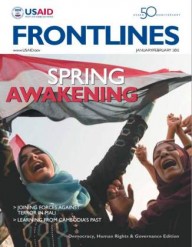

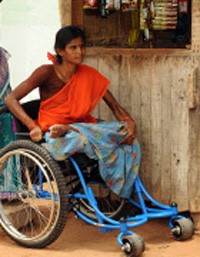
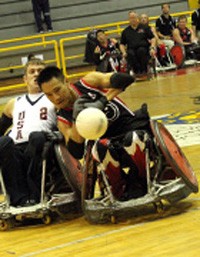
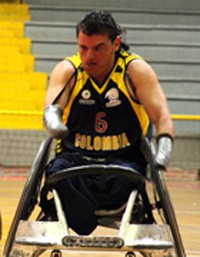
Comment
Make a general inquiry or suggest an improvement.